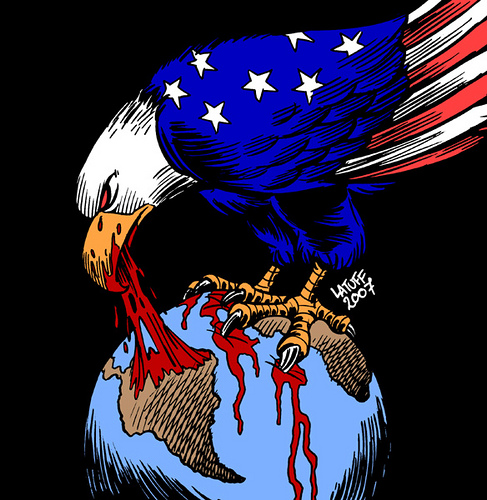
President Hugo Chavez’s rise to power in Venezuela on Feb. 2, 1999 coincided with a traumatic military event for the United States: The closure of its principal military facility in the region: Howard Base, located in Panama, shut down in accordance with the Torrijos-Carter Treaties of 1977.
In its place, the Pentagon designated four locations to control the region: Manta in Ecuador, Comalapa in El Salvador and the islands of Aruba and Curacao, which are under Dutch sovereignty.
The U.S. added new official tasks to its so-called traditional mission of espionage, such as monitoring drug trafficking and combating underground immigration into the U.S., along with other secret tasks like countering Colombian insurgents, controlling the flow of minerals and oil, and managing resources such as fresh water and biodiversity. But since the beginning, its principal objectives were to keep an eye on Venezuela and to destabilize the Bolivian Revolution.
After 9/11, American Secretary of Defense Donald Rumsfeld defined a new military doctrine to confront “international terrorism.” He modified the strategy of overseas deployment, which previously involved equipping large bases with numerous personnel. He replaced these megabases with a large number of Forward Operating Locations (FOL) and Cooperative Security Locations (CSL) that contain little military personnel but are equipped with ultramodern detection technology.
The result: In such a short time, the quantity of overseas American military facilities have multiplied, reaching the unprecedented sum of 865 FOL or CSL-type bases spread throughout 46 countries. Never before in history has a power so rapidly increased its military control posts around the world.
In Latin America, the redeployment of bases has already permitted the facility in Manta, Ecuador to participate in the failed state coup d’état against President Chavez on April 11, 2002. Since then, a media campaign directed by Washington began to disseminate false information about the supposed presence of Hamas, Hezbollah and al-Qaida cells in the country.
Under the pretext of monitoring such movements, and in retaliation against a Caracas government that in May 2004 ended 50 years of U.S. military presence in Venezuela, the Pentagon widened the use of its military bases in Aruba and Curacao, which are situated very close to the Venezuelan coast where U.S. warships have recently increased their visits.
This activity has been denounced recently by President Chavez: “It would be good for Europe to know that the North American empire is arming these islands Aruba and Curacao to the teeth, filling them with war planes, war ships and CIA spies … I am accusing the Kingdom of the Netherlands together with the Yankee empire of preparing a military aggression against Venezuela.”
In 2006, “21st century socialism” had begun to be spoken about in Caracas, the Bolivarian Alliance for the Americas (ALBA) was born and Hugo Chavez was re-elected president. Washington reacted by imposing an embargo on the sale of arms to Venezuela, under the pretext that Caracas is not “cooperating fully with United States antiterrorism efforts.”
The F-16s of the Venezuelan Air Force have been kept in disrepair. Given this situation, the Venezuelan authorities established an agreement with Russia to equip its air force with Sukhoi aircraft. Washington denounced the presumed “massive rearmament” of Venezuela, failing to mention that the countries with the leading military budgets in Latin America are Brazil, Colombia and Chile, and that Colombia receives $630 million of American military aid (about 420 million Euros).
On March 1, 2008, Colombian forces, with help from the Manta base, attacked a FARC camp located within Ecuador. Quito, in retaliation, decided not to renew the agreement on the Manta base that was ready to expire in November 2009. Washington responded the following month with the reactivation of the Fourth Fleet, (deactivated in 1948, 60 years ago) whose mission it is to patrol the Atlantic Coast of South America. A month later, the South American states met in Brasilia and answered back with the creation of the Union of South American Nations (UNASUR) and, in March 2009, with the South American Defense Council.
A few weeks later, the ambassador of the United States in Bogota announced that the Manta base would be relocated in Palanquero, Colombia.
In June, with the support of the U.S. base in Soto Cano, a coup d’état was carried out in Honduras against President Manuel Zelaya, who had joined his country with ALBA. In August, the Pentagon announced that seven new military bases would be established in Colombia. And in October, the conservative president of Panama, Ricardo Martinelli, admitted that he had ceded the use of four new military bases to the United States.
Thus, Venezuela and the Bolivian Revolution see themselves surrounded by no less than thirteen U.S. military bases located in Colombia, Panama, Aruba and Curacao, as well as the aircraft carriers and warships of the Fourth Fleet. President Obama seems to have given the Pentagon a free hand. Everything points to an imminent attack. Will the people consent to another crime to be committed against democracy in Latin America?

Leave a Reply
You must be logged in to post a comment.